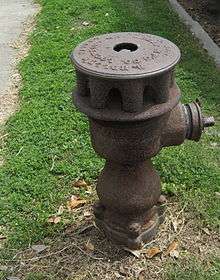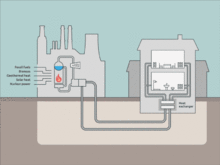Birdsill Holly


Birdsill Holly Jr. (8 November 1820 – 27 April 1894) was a mechanical engineer and inventor of water hydraulics devices. He is noted for his inventions related to city water system equipment and apparatus for fire protection, like the fire hydrant.
Early life
Holly was born 8 November 1820 in Auburn, New York. His father was Birdsill Holly, Sr. and his mother was Comfort Holly. When Holly was born his father moved the family to Auburn to become part of the crew constructing the new prison facility being built in the area. Eventually that work ended and then his father found a job at the Auburn Theological Seminary in construction. Eventually that work ended also. His father then tried farming, without very much success. Holly's father then moved the family to Seneca Falls, New York, where there was a water-powered industry with many jobs. Holly grew up in the Seneca Falls, New York, area since his father was able to find work as a millwright and general mechanic.[1]
Holly was forced then to drop out of school to help support the family at the age of 10 when his father died prematurely. Holly was only in the third grade. He was influenced by his father and took an interest in similar trade skills of mechanical engineering. Holly first became an apprentice in a cabinetry shop and then he apprenticed in a machine shop. In his late teens Holly became a superintendent in a machine shop and later an owner of a machine shop in Uniontown, Pennsylvania.[2][3]
Career




Birdsill Holly hydrant patent drawings
Holly eventually moved back to Seneca Falls in his early twenties and became one of the partners of a new firm called Silsby, Race and Holly in 1845.[4] The firm manufactured hydraulic machinery and steam-powered fire engines.[5] Holly was the firm's visionary and contributed much to their success.[5] There in 1849 he received his first patent, which was for a rotary water pump.[4]
Holly was a co-inventor of the Silsby steam fire engine in 1855, which was first produced in 1856. Ultimately over a thousand were made, becoming the most popular steam fire engine built in the United States.[3] The unconventional rotary motion steam-cylinder engine and pump were Holly's invention (US39259A and US12350A). The first of these machines weighed up to 9,500 pounds, producing 60 pounds of steam pressure so it could throw four streams of water over 200 feet. If six fire hoses were used the streams of water were about 150 feet each. The nozzles to the fire hoses were just a little over one inch. The greatest distance recorded for a stream was 364 feet on 24 September 1881 in Reading, Pennsylvania.[6]
Holly left Seneca Falls in 1851 for Lockport, New York, where he established Holly Manufacturing Company in 1859 with the financial assistance of Washington Hunt and Thomas Flagler.[4] The company produced sewing machines, cistern pumps, and rotary pumps. Holly built the Lockport Fire Protection and Water System in 1863, which used pumps powered by water-turbines and steam-engines to bring water to hydrants in the city.[5] He patented a fire hydrant in 1869 used for fire protection.[7]
Holly's machinery inventions pumped water under pressure directly into city main water supply lines, since there were no water towers at the time for pressure from a local water supply reservoir for drinking water and fire protection.[5] The pumps ran at various speeds according to usage. It was regulated by the pressure in the discharge main.[5] Holly's company facilities doubled when he built a similar system for the city of Lockport water works department. He applied his water works system equipment in over two thousand cities in the United States and Canada.[5]
Holly's system of pumping water into Lockport's city mains was unique. It not only supplied drinking water for domestic service, but also furnished water under pressure for hydrants in a city fire protection service.[5][8] His technology innovations provided the impetus for similar future city water works construction projects across the United States.[9]
Holly’s interests changed later from fire protection systems to the problem of heating buildings from a central point for better energy efficiency. He wondered if maybe there couldn't be a more efficient way of heating several nearby buildings than with individual small boilers in each building. He then set up an experimental steam heating system at his home in Lockport in 1876. Holly ran a short underground pipe line from his house to his barn in the back. Through this wooden pipe he ran steam and found that there was little heat loss. He next ran a longer 100 foot pipe to a neighbor's property for his steam experiment to transfer heat. The experiment worked successfully and he convinced others of the possibility of wide-scale central steam heating.[2][5][10]

(click image to see how system works)
Holly then formed a company from interested investors in his steam concept of a central point to make heat. He combined this company of investors with his Holly Manufacturing Company, coming up with Holly Steam Combination Company in 1877 for the commercial distribution of heat from a central station, developing district heating for towns and cities across the United States and Canada. Holly’s district heating system used a large boiler at a central plant factory location. This system furnished steam to a group of town buildings in a surrounding city district through a circuit of water pipes that supplied the steam vapors and returned the liquid water after being condensed. They were insulated to reduce loss of heat energy. The serviced buildings were metered and charged for the heat consumed from the steam supply. The metering was done by the water condensation of the steam they received. Holly with his companies designed and invented all the necessary control regulators and measuring devices to run a city district of buildings to heat.[2][5][10]
Holly patented 150 inventions in his life time.[3] He was a friend of the renowned inventor Thomas Edison. Edison once asked Holly to become an assistant at his research laboratory in Menlo Park, but he refused wishing to concentrate on his own businesses instead.[11]
Future plans
Holly had the dream of making a nineteen story skyscraper building. He thought that someday Niagara Falls would become a tourist attraction, so proposed the idea of constructing a 700-foot (210 m) structure on Goat Island near the falls for viewing. This, however, did not transpire because of financing. He could not get enough investors for such an expensive, highly speculative, project. The concept of such heights for skyscraper buildings did transpire however in New York City shortly before his death in 1894, but were not of his architectural concepts.[12]
Nearby there is a tourist viewing structure, that has a height measuring 775 feet (236 m) from the bottom of the falls.[13]
Works
The following are some of his 150 patents –
- February 6, 1855 – Elliptical or Rotary pump (US12350 A)
- July 3, 1855 – Method of regulating issue-apertures and of suspending turbine wheels (US13172 A)
- July 14, 1863 – Improvement in pumps (US39259 A)
- November 15, 1864 – Improvement in pumps (US45040 A)
- January 31, 1865 – Hot air furnace (US46107 A)
- September 14, 1869 - Improvement in hydrants (US94749 A)
- November 5, 1872 – Improvement in systems of water-supply for cities (USRE5133 E)
- October 5, 1880 – Steam Heating Radiator (US232821 A)
Death
Birdsill Holly died on April 27, 1894, at 7pm. He had suffered from a long illness and the cause of death was listed as heart failure.[5]
References
- ↑ Daisy, Michael (2015). "Who Invented The Fire Hydrant? The Story of Birdsill Holly". The Inventor Spot. Halcyon Solutions Inc. Retrieved January 2, 2016.
While Holly was only one of many involved in the development of the fire hydrant, innovations he introduced are largely responsible for the fire hydrant we take for granted today.
- 1 2 3 Rogers 2010, p. 89.
- 1 2 3 Hart, Marion (2012). "Birdsill Holly, Jr.". Retrieved January 1, 2016.
- 1 2 3 Daisy, Michael (2015). "Who Invented The Fire Hydrant? The Story of Birdsill Holly". Retrieved January 3, 2016.
- 1 2 3 4 5 6 7 8 9 10 "Lockport Cave & Underground Boat Ride". Dennis Stierer. 2016. Retrieved January 1, 2016.
- ↑ King 1896, pp. 21–24.
- ↑ Hinds 2012, p. 45.
- ↑ Purdue 1997, pp. 1,10.
- ↑ ScrantonPub 1920, p. 33.
- 1 2 Hager 2016, p. 2168.
- ↑ Hinds 2012, p. 36.
- ↑ Hinds 2012, p. 37.
- ↑ "Skylon Tower". Niagara Falls Info. Retrieved January 4, 2016.
Sources
- Hager, Willi H. (4 January 2016). Hydraulicians in the USA 1800–2000: A biographical dictionary of leaders in hydraulic engineering and fluid mechanics. CRC Press. ISBN 978-1-315-68012-5.
- Hinds, Conrade C. (9 October 2012). The Great Columbus Experiment of 1908: Waterworks that Changed the World. Arcadia Publishing. ISBN 978-1-61423-685-6.
In 1869, Holly was issued US patent #94749 for an improved fire hydrant.
- King, William T. (1896). History of the American steam fire-engine. Pinkham Press.
- Purdue (1997). Landmarks in Mechanical Engineering. Purdue University Press. ISBN 978-1-55753-093-6.
- Rogers, Dave (6 January 2010). Inventions and Their Inventors. M-Y Books Distribution. ISBN 978-1-906986-58-2.
- ScrantonPub (1920). Water and Sewage Works. Scranton Publishing Company.
The Holly system, as all know, consisted of pumping directly into the mains without the intervention of standpipes or reservoirs, the pumps running at a widely varying speed according to consumption. The Holly system gave the initial impetus to water works construction in the early years following the Civil War, and soon had many imitators. The essence of the system was an automatic pump regulator actuated by the pressure in the discharge main.
External links
| Wikimedia Commons has media related to Birdsill Holly. |
- Holly's patent fire hydrant
- The Silsby engine – rotary steam engines
- Jon Szpakowski's Hydrant Collection / Patent 1869 Holly Mfg. Co. Hydrant